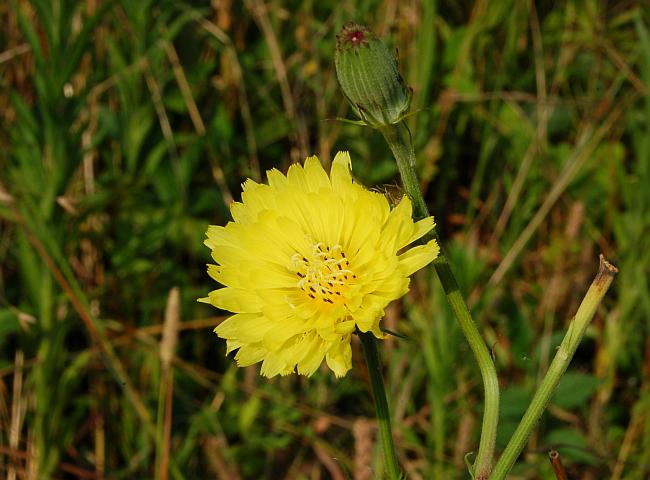Pyrrhopappus carolinianus (Walter) DC.
False Dandelion

Native
CC = 0
CW = 5
MOC = 71
© SRTurner
Pyrrhopappus carolinianus (Walter) DC.False Dandelion | |
 |
Native CC = 0 CW = 5 MOC = 71 |
© SRTurner |
|
Family - Asteraceae/Cichorieae Habit - Taprooted annual forb with milky latex. Stem - Ascending to erect, to 75 cm, usually branched, finely ridged, minutely hairy toward the tip, often glabrous near the base.
Leaves - Basal and alternate, sessile or with a short, winged petiole, the base frequently slightly expanded or with a small pair of auricles and somewhat clasping the stem. Leaf blades 3-25 cm long, linear to more commonly oblanceolate, ranging from pinnately several-lobed, the lobes usually slender with rounded or sometimes angled sinuses, to unlobed and entire or nearly so, both surfaces glabrous or the undersurface sparsely and minutely hairy along the midvein. Venation of 1 main vein and a faint network of anastomosing secondary and sometimes also tertiary veins.
Heads - Usually solitary at the branch tips, appearing long-stalked. Involucre 15-25 mm long at flowering, cup-shaped, the bracts in 1 long inner and 2 or 3 shorter outer series, glabrous or pubescent with dense, minute hairs, those of the outer series 13-17, variously 4-11 mm long, linear to narrowly lanceolate, usually purplish-tinged toward the tip; those of the inner series more or less equal, 17-21, with an abrupt, small, purple to brown, crestlike thickening just below the tip, because of this often appearing irregular, notched, or jointed near the tip. Receptacle naked.
Florets - Ligulate florets 55-140. Corollas 9-22 mm long, bright yellow, occasionally somewhat brownish- or purplish-tinged on the outer surface. Pappus 7-12 mm long, of numerous apparently smooth (microscopically barbed) bristles, straw-colored, tan, or light reddish brown, persistent at fruiting, a dense ring of minute, reflexed, white hairs attached immediately below the pappus bristles. Disk florets absent.
Fruits - Achenes 11-16 mm long (including the beak), the body narrowly oblong-elliptic in outline, not flattened, deeply 5-grooved, tapered at the tip to a slender beak usually longer than the body, the pappus attached to a more or less unexpanded tip, the surface of the rounded ribs minutely roughened with ascending tubercles or barbs and also appearing faintly or finely cross-wrinkled, otherwise glabrous, brown to reddish brown.
Flowering - May - October. Habitat - Prairies, glades, swamps, streambanks, pastures, fields, open disturbed areas. Origin - Native to the U.S. Lookalikes - Numerous other members of the Cichorieae tribe, especially those in the genera Sonchus, Crepis, Hieracium, Krigia, Hypochaeris, and Leontodon. Other info. - This pretty species is found throughout the state. It is also common throughout the southeastern quadrant of the continental U.S., but absent from other parts of the country. Its situational preference is somewhat difficult to characterize, as it pops up sporadically in a number of different habitats. It is tolerant of disturbance and a wide variety of moisture levels. Photographs taken by DETenaglia, also at Shaw Nature Reserve, Franklin County, MO, 7-8-2006, Howell Island, St. Louis County, MO, 8-2-2009, just east of Howell Island, St. Louis County, MO, 7-18-2013, Blue River fishing and hunting reserve, Johnston County, OK, 7-27-2016, Otter Slough Conservation Area, Stoddard County, MO, 9-11-2019, Allenton Access, St. Louis County, MO, 8-2-2020, and Marais Temps Clair Conservation Area, St. Charles County, MO, 8-5-2021 (SRTurner). |